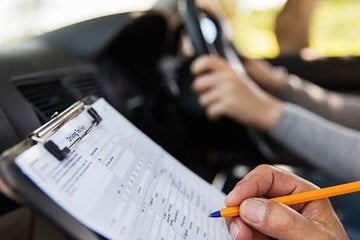Key points:
The most common reasons for failing an MOT are:
- Lights and signals
- Suspension
- Brakes
- Tyres
- Windows and mirrors
- Body, chassis and structure
- Noise, emissions and leaks
MOT checklist: What to check before your MOT
These are the most common reasons for MOT failure according to GOV.UK. It's worth checking these areas before you take your car for its MOT. You might be able to fix some of these yourself, but others require a mechanic:
1. Lights
Over 11% of vehicles failed their MOT because of their lights between 2022 and 2023.
So before you take your car for its MOT, check all lights are working correctly. This includes:
- Headlights
- Rear lights
- Fog lights
- Brake lights
- Indicator lights
- Hazard lights
If your headlight bulbs have blown, you should change them straight away. But brake lights and hazard lights, for example, might not be so obvious.
You might be able to change the bulbs yourself. Your car’s manual should be able to tell you how to do this.
Check that all warning lights on your dashboard are working too. Usually they illuminate when you turn your car on.
2. Suspension
Suspension problems are another common reason for a car to fail its MOT. Nearly 9% of cars fail their MOT because of this. You might notice your car has suspension issues if:
- Your car leans to one side
- Your journey in your car is bumpier than usual
- Your car drifts when you go around corners
- You can hear a knocking sound
If you’re noticing this before your MOT it’s definitely worth having a mechanic check your car.
3. Brakes
Nearly 7% of cars fail their MOT because of their brakes.
If there are issues with your brakes you might notice there’s some vibration through the steering wheel. You might feel this through your brake pedal too.
We’re not going to recommend you trying to fix your brakes unless you know exactly what you’re doing, you should get your mechanic to do this.
4. Tyres
Over 6% of cars failed their MOT because their tyres weren’t a good standard.
But it’s relatively easy to change your tyres. So if you didn’t want a mechanic to change them for you, you could just pay the cost of the tyre and fit them yourself. A standard tyre can cost £45 to £70 according to check a trade.
When you’re checking your tyres, you need to check that there aren’t any:
- Cuts
- Bulges
- Tears
- Stones
- Nails
- Damage to the tyres side wall
You also need to check your tyres aren’t bald. You can do this by putting a 20p coin in the main grooves of the tyre. If you can’t see the outer rim of the coin, then your tread depth should be above the legal limit.
It’s also worth checking your tyre pressure at a garage or with a pressure gauge. You can find the recommended tyre pressures in your car’s manual.
Our guide on how to check your tyre pressure and tread depth can give you more information on tyre health.
4. Visibility - windows and mirrors
Almost 5% of cars failed because of poor visibility. Nothing should obstruct your view of the road, so remove any air fresheners from your rear view mirror. Remove sat nav cradles and stickers too if they block your view.
You should also check wiper blades for damage. If they're worn, you can replace them yourself using your vehicle handbook for reference. Mirrors should be secure and intact.
5. Body, chassis, structure
Nearly 4% of vehicles failed their MOT because of their defects with the vehicle’s structure.
So when you’re checking your car, look out for any signs of rust. And make sure the boot and bonnet open and close securely.
It’s also worth looking underneath your car at the chassis and frame to make sure there’s no rust or obvious damage.
6. Noise, emissions and leaks
Over 3% of cars fail because of issues with noise, emissions and leaks. To check for this, listen for any strange noises. This could mean there are issues with the exhaust or engine components.
If your car hasn’t been running well, for example, if your fuel efficiency isn’t as good as usual, it could be your emissions. Get a mechanic to check this for you.
Check where your car is usually parked for any signs of fluid leaks. This could be:
- Oil
- Brake fluid
- Coolant
- Transmission fluid
Take a look at the petrol inlet filler cap. The petrol inlet is where the fuel goes, and the filler cap is what you screw onto it. Look out for any damage to the seal around the cap.
You should also check your catalytic converter too.
Other things to do before you take your car for its MOT:
-
Clean your car. Your registration plates must be readable and in good condition. Also, if your car is dirty and full of clutter the tester can refuse to carry out the inspection.
-
Documentation. Make sure the Vehicle Identification Number (VIN) matches the VIN in your car’s log book.
-
Fluid levels. Check that your screen wash, brake fluid and oil are at suitable levels. If not, top them up.
-
Test your horn. It should be audible.
Fixing these before your MOT means you save either the retesting fee which is £54.85. Or if it’s within 10 working days, the partial retesting fee which is around £27.45.
What happens if my car fails its MOT?
If your car fails its MOT with major or dangerous faults, you have to get each problem fixed and book another MOT. This is a partial MOT though, and only tests the areas that your car failed in last time. You can book a retest within 10 days, giving you plenty of time to arrange repair work.
The MOT test can also identify other, less immediate problems. These appear as ‘minor faults’ on your certificate.
Minor faults aren’t yet serious enough to cause your car to fail its MOT. For example, if you have worn tyres, but they're not worn below the legal limit.
MOTs can be expensive, so it might be more cost effective to get the minor faults sorted a month or so after the initial test.
That way the faults don’t develop and put you in danger. You stand a better chance of passing it the following year too.
Some garages might also give your car advisories. These don’t need fixing as urgently as minor faults and won’t cause your car to fail its MOT. If you have advisories you should monitor them and get them repaired if necessary.
Can I drive my car if it fails its MOT?
If your MOT comes back with dangerous faults you can’t drive it until your mechanic has made the repairs. Major faults should be repaired as soon as possible.
You should be able to drive your car if it has advisory faults. These are recommendations made by the garage that should be repaired at some point.
If you’re caught driving a car that’s unroadworthy you could:
-
Be given a fine of up to £2,500
-
Get points on your licence
-
Get a driving ban
Having a motoring conviction like this could increase your car insurance costs.
When should I MOT a new car?
If your car is new, you won’t need to take it for an MOT for 3 years. Otherwise you should take your car for an MOT every year.
You can find out when your MOT is due using our MOT status tool.
Set reminders for your MOT in our app
But the government is considering changing the frequency of MOT tests from yearly to every other year.
The government is considering changing first MOTs for new vehicles too. If the government introduced the changes, new vehicles might not need an MOT for 4 years.
The MOT changes apply to cars, motorbikes and vans.
The government says that the changes to MOTs reflect the improvements to vehicle safety, for example automatic lane keeping systems (ALKs).
This might cause some safety concerns for motorists. But government analysis revealed that new vehicles usually pass their MOT in the first 3 years. And that in the UK, casualties due to vehicle defects are low.
It’s standard practice to test new vehicles at 4 years in countries like:
-
Belgium
-
Denmark
-
France
-
Italy
-
Spain
-
Portugal
Some drivers might be happy with less frequent MOTs. The average MOT costs £40, so the new changes could save motorists across the UK £100 million a year.
But it’s important to make sure you’re still getting regular services and not ignoring problems with your vehicle. This should also mean you have less problems when you do get an MOT.
What our motor insurance expert says
“Motoring costs have a huge part to play in the increased cost of living at the moment. So drivers will be pleased to hear of these potential changes to MOT rules, which could lighten the strain on their pockets.
“But our research reveals that nearly 1 in 4 (24%)* are willing to sacrifice a vehicle service to save a bit of money. It’s important that drivers don't skip services when they need them. This will be especially important if MOT services extend from yearly to every other year.
“If you're worried about a problem with your car, have it serviced as soon as you can. That way, you're less likely to face problems and higher costs when your MOT comes around. If you're unsure about whether your vehicle might need checking, our guide on car servicing can help.”

The government is also looking at how MOTs could help monitor emissions. This should reduce pollution and help with vehicle's environmental efficiency. The government is also consulting on:
- Electric vehicle batteries and whether they should be tested to improve their safety and reliability
- More plans to deal with excessively noisy vehicles
- How the Driver and Vehicle Standards Agency (DVSA) can stop MOT and mileage fraud
The public consultation launched on 18 January 2023 to seek views on the new MOT rule changes.
How long after my MOT expires can I drive?
There's no grace period if your MOT has expired. As soon as your MOT has expired, you’re not legally allowed to drive your car.
The only time you’re able to drive your car is to a pre-booked MOT appointment.
This is why it’s important to be organised, and make sure you know when your current MOT is due to expire. That way you can get your car booked in for its next one in good time.
Compare car insurance quotes
*Unless otherwise stated, all figures taken from omnibus research carried out by One Poll on behalf of Confused.com. This was an online poll of 2,000 UK drivers. The research was conducted between 25 May 2022 and 30 May 2022.








